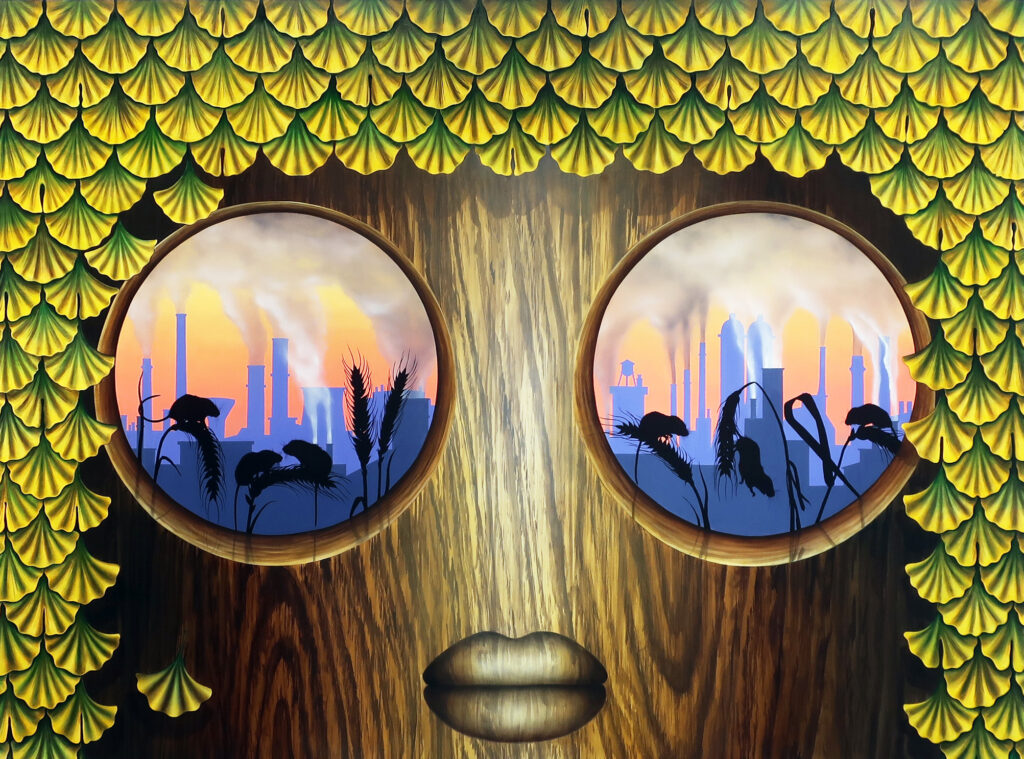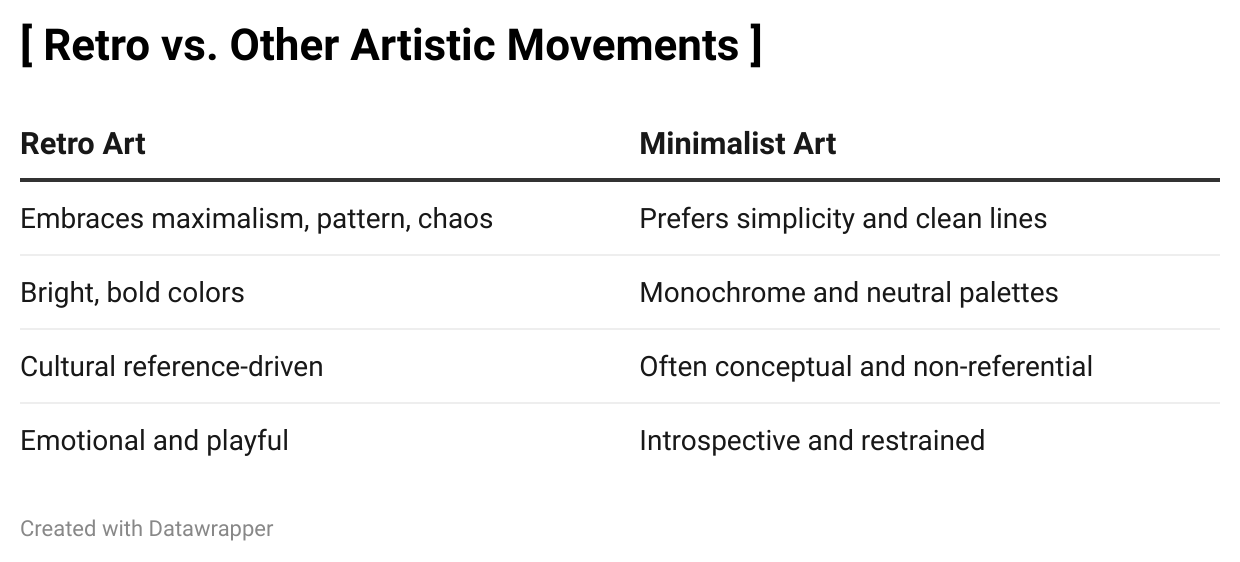
Introduction
The art world has always been cyclical, with trends resurfacing in new and exciting ways. In 2025, the “Retro Revival” is in full swing, breathing new life into vintage aesthetics and reshaping modern creativity. From 1960s psychedelia and 1980s pop flair to the grunge textures of the 1990s, artists are embracing the past not as nostalgia alone, but as a canvas for reinvention. This isn’t just about looking backward—it’s about using the past to challenge, comfort, and captivate audiences in the present.
What Is the Retro Revival in Art?
The Retro Revival refers to a trend in contemporary art where artists borrow visual styles, motifs, and techniques from past decades—most notably the mid-20th century—and reimagine them using modern tools and contemporary themes. This includes everything from pixel-inspired digital works and neon palettes to analog collage, retrofuturism, and even re-creations of vintage advertising styles.
Key Characteristics:
Bold, saturated color schemes
Graphic design elements from the 60s–90s
Hand-drawn typography and poster-style layouts
Analog texture mimicked digitally (e.g. VHS distortion, halftone dots)
Pop culture references from earlier decades
This resurgence isn’t just about aesthetics—it’s a rebellion against sterile minimalism and a celebration of cultural memory.
Why Vintage Is Back: Cultural, Emotional, and Visual Appeal
In a world increasingly shaped by screens, algorithms, and artificial intelligence, retro art offers something tactile, familiar, and emotionally resonant.
Why audiences and artists are gravitating toward retro:
Comfort in Familiarity: Amid global uncertainty, people are drawn to visuals that remind them of simpler or more optimistic times.
Counterpoint to Digital Coldness: Retro styles reintroduce warmth, imperfection, and hand-crafted charm.
Identity & Pop Culture: Vintage aesthetics allow artists to explore identity, consumerism, and history through a culturally rich lens.
Instagram & TikTok Appeal: Retro visuals perform well on social media—making them not just emotionally resonant but algorithmically favored.
This style speaks across generations—evoking childhood memories for some, and vintage cool for others.
Top-Selling Retro-Inspired Works and Market Movement
Retro art is more than a visual trend—it’s a financial one. Collectors are snapping up pieces that evoke the past while holding future value.
Recent notable sales include:
Kaws – “Untitled (KawsBob)”
A reimagination of SpongeBob SquarePants through the lens of 90s pop art. Sold for $2.6 million at auction.Takashi Murakami – “Flowers & Skulls” Series
Melding anime nostalgia with psychedelic color palettes. Murakami’s work consistently sells in the $1–5 million range.Mr. Doodle – “The Doodle World”
With 80s and 90s energy, Mr. Doodle’s whimsical compositions have fetched up to $1.1 million in recent auctions.Julie Curtiss – “Pink Cigarette” (2022)
With graphic elements echoing mid-century advertising, this painting sold for $495,000, more than double its estimate.
Retro aesthetics are proving to be smart investments, especially among emerging collectors and design-forward buyers.
Top Artists Behind the Retro Movement
Many contemporary artists are leading this revival, each interpreting retro motifs through a unique cultural and personal lens.
Katherine Bernhardt – Known for her large-scale paintings of 80s and 90s consumer icons (Garfield, Swatches, Fruit Loops).
Emily Mae Smith – Combines Art Nouveau, cartoons, and 70s psychedelia in subversive narrative paintings.
Guy Yanai – Uses blocky brushstrokes and bold colors reminiscent of early computer graphics and vintage interiors.
Tina Yu – Creates retro-pop-inspired sculptures influenced by 90s Asian toys and Y2K culture.
James Jean – Blends 50s-60s comic book art with mythological surrealism in highly detailed work.
These artists draw from the past but speak urgently to the present—making them marketable, collectible, and critically respected.
Retro vs. Other Artistic Movements
Retro art doesn’t exist in a vacuum. Its explosive color and nostalgic appeal often place it in contrast with other dominant styles.

Retro art offers warmth and relatability, especially for younger audiences exhausted by sleek digital branding and design.
Design, Interiors, and the Rise of Retro Collectibles
The Retro Revival isn’t limited to gallery walls. Interior designers and fashion houses are bringing retro art into homes, pop-up shops, and flagship stores.
Mid-century modern and Memphis styles are blending with 70s-style prints in interior design.
Home décor brands like Urban Outfitters and Society6 are partnering with retro-themed artists.
Album art and film posters are increasingly mimicking 80s layouts and neon palettes.
Merchandising and Licensing – Artists with retro styles are landing licensing deals with brands, elevating their cultural relevance and value.
In 2025, retro style is a commercial and aesthetic powerhouse.
The Role of Technology in Amplifying Retro
Paradoxically, the Retro Revival is powered by modern tech:
Digital illustration tools mimic vintage effects (e.g., halftone, aged textures, VHS fuzz).
NFTs and blockchain art have retro-inspired aesthetics like pixel art and arcade-game visuals.
AI-generated vintage posters now circulate widely, showing how machines can remix past aesthetics for new audiences.
Augmented reality (AR) lets users “step into” retro art environments in museums and at home.
Retro isn’t just a style—it’s a storytelling medium amplified by 21st-century tools.
Where the Trend Is Heading
The Retro Revival shows no signs of fading. Its trajectory is upward, driven by collector enthusiasm, designer interest, and expanding digital platforms.
Gallery Representation – More galleries are showcasing retro-inspired work, particularly in pop-up exhibits and international fairs.
Emerging Artists – The aesthetic is being picked up by MFA graduates who grew up in the 90s and early 2000s.
Cross-disciplinary Reach – Retro themes are influencing music videos, fashion shows, and advertising campaigns.
Price Appreciation – Early retro works by emerging stars are beginning to command higher price points, with ROI appealing to young investors.
Expect to see more immersive retro exhibitions, hybrid installations, and digital crossovers in 2025 and beyond.
Conclusion
The Retro Revival is more than a nostalgic nod to the past—it’s a visual language being used to navigate a complex, digital, and emotionally hungry present. Whether through pop iconography, vintage textures, or hand-drawn homages to decades gone by, retro-inspired art speaks to the timeless human desire for memory, meaning, and beauty. As collectors embrace the style and artists continue to innovate within it, vintage aesthetics are securing their place in the contemporary canon.
The art piece used in this post is called “Head, Horizon World” by Emily Mae Smith
For Inquiries and Exclusive Promotions:
Explore our curated offerings at Artists Breath.
Discover Our Exquisite Collection:
Immerse yourself in our distinguished selection of fine art at Artists Breath Collection.
Connect with Our Artists and Gallery:
For personalized assistance or to engage with our talented artists, please reach out at info@artistsbreath.com.
Stay Informed with Our Insights:
Subscribe to our Substack for the latest in art and culture at Artists Breath Substack.